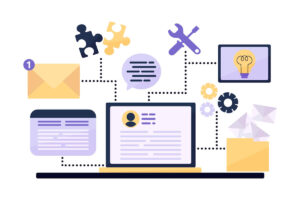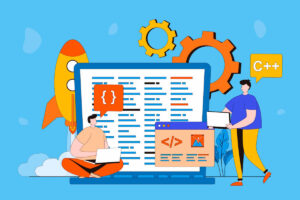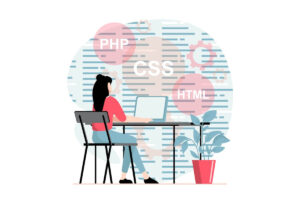In the realm of web development, mastering the art of using PHP can be the key to unlocking endless possibilities for your business or personal projects. This guide, specially tailored for beginners, will walk you through the basics of PHP and set you on the path to creating your first interactive website. By the end, you will have gained the foundational knowledge needed to explore more advanced topics in PHP. This guide emphasizes “PHP for beginners”, ensuring that even those with no prior experience can follow along. So, let’s get started on your PHP journey!
Importance of PHP
PHP, or Hypertext Preprocessor, stands as a pillar in the world of web development. Its wide adoption and ease of use make it an essential skill for beginners eager to develop interactive websites. PHP operates on the server side, adding a layer of interactivity that HTML alone cannot achieve. This section underscores the importance of PHP for beginners, setting the stage for the subsequent, more hands-on parts of the guide.
Getting Started with PHP
Before diving into the world of PHP programming, it’s essential to have the right development environment set up. This initial step will enable you to write, test, and debug your PHP scripts efficiently.
Setting up a PHP Development Environment
Setting up a PHP development environment involves a few key components: server software (like XAMPP or MAMP), a text editor (such as Visual Studio Code or Sublime Text), and a web browser. Installing server software will allow you to run PHP scripts locally on your computer, mimicking a live server environment.
Basic PHP Syntax and Concepts
PHP syntax is the set of rules that define how PHP programs are written and interpreted. At its core, PHP syntax is designed to be straightforward, allowing beginners to quickly grasp the essentials. You’ll learn about variables, data types, operators, and control structures, which are foundational concepts for programming in PHP.
Your First PHP Script
With a development environment set up and an understanding of basic PHP syntax, it’s time to write your first PHP script. This section will guide you through creating a simple “Hello World!” program, explaining each step along the way.
Writing and Executing a Simple “Hello, World!” Script
Your first venture into PHP programming will be writing a basic script that displays the message “Hello, World!” on a webpage. This script will consist of a simple PHP code block embedded within an HTML file. By doing so, you will see firsthand how PHP integrates seamlessly with HTML to produce dynamic content.
Understanding How PHP Integrates with HTML
PHP can be embedded directly into HTML code or used in conjunction with CSS and JavaScript to create fully interactive web pages. This flexibility allows developers to start with basic PHP scripts and gradually increase complexity as they become more comfortable with the language.
Beginning your PHP development with these foundational steps will set you on the path to creating interactive and dynamic websites. Remember, every great developer started with a simple “Hello, World!” – the possibilities that follow are limitless.
Handling User Input
One of the most powerful features of PHP is its ability to handle user input, making it an essential skill for PHP for beginners. Creating and processing HTML forms with PHP allows developers to collect data from users, such as login information, feedback, and more. It is crucial, however, to ensure that user input is validated for security reasons, to prevent common vulnerabilities like SQL injection and cross-site scripting (XSS).
Managing Web Pages with PHP
PHP’s capability to create dynamic web pages is one of its standout features. By using PHP, developers can generate content on the fly, customize user experiences, and manage site content efficiently. An understanding of GET and POST methods in PHP is fundamental in this regard, as these methods enable the transfer of data between web pages and servers.
According to recent statistics, over 76.5% of all websites using a server-side programming language use PHP, underscoring its importance in web development.
This statistic highlights the relevance of mastering PHP for beginners who are looking to make a significant impact in the web development world. By leveraging PHP’s features to handle user input securely and manage web pages dynamically, developers can build robust, interactive websites that cater to the needs of diverse audiences.
Connecting to a Database
For PHP for beginners, understanding the concept of databases in web development is crucial. A database serves as a repository for storing, retrieving, and managing data in a structured format. PHP’s compatibility with various database management systems, including MySQL, the most popular, enables developers to create dynamic, data-driven websites. Introduction to MySQL and its seamless integration with PHP allows for performing basic database operations easily. These operations include creating, reading, updating, and deleting data (CRUD operations). This integration plays a significant role in web application development, making it a vital skill for newcomers in the PHP landscape.
Session Management in PHP
Session management is an indispensable feature in developing interactive web applications. It helps in understanding sessions and cookies, which are paramount for implementing user authentication and maintaining session states across various web pages. PHP offers straightforward session management functions that allow developers to store user information securely over multiple requests. This capability is essential for creating personalized user experiences and is a fundamental aspect of PHP for beginners to grasp. Furthermore, understanding session management paves the way for utilizing advanced PHP frameworks, which are designed to streamline and enhance the development of more complex web applications.
Designing an Interactive Website
When venturing into web development, PHP beginners must understand the planning and designing phases of a project. The initial step in creating an interactive website is to clearly define its purpose and the target audience. This clarity helps in tailoring the design and functionality to meet the needs of its users effectively. A basic project such as a simple blog or personal website serves as an excellent starting point for novices.
Planning and Designing a Basic Project
A successful project begins with a detailed plan that outlines the website’s structure, features, and the technologies that will be used. For a simple blog or personal website, sketching a wireframe can help visualize the layout and user interface. The next step involves choosing a suitable database (MySQL is popular among PHP developers) for storing posts, comments, and user data.
Step-by-Step Guide to Building a Simple Blog or Personal Website
- Project Setup: Install a local server environment (XAMPP, WAMP) and create a project folder.
- Database Creation: Utilize MySQL to create a database for your site. This will handle posts, comments, and user registrations.
- PHP Coding: Start by setting up the homepage, and gradually add features such as user registration, login functionality, and posting articles. Utilize PHP sessions for user authentication across pages.
- Design and User Interface: While PHP handles the backend, use HTML, CSS, and JavaScript for the front end to make your site visually appealing and responsive.
- Testing and Debugging: Test your website extensively on different devices and browsers and fix any bugs.
Best Practices and Security
For PHP beginners, adhering to coding best practices is essential for developing maintainable and scalable applications. Some key practices include using meaningful variable names, commenting code for clarity, and following a consistent coding style. Also, understanding the core PHP functions and mastering the use of arrays, strings, and custom functions can significantly enhance your coding efficiency.
Basic Security Considerations when Developing with PHP
Security should never be an afterthought in web development. Basic security considerations include protecting against SQL injection by using prepared statements with PDO, validating and sanitizing user input to prevent XSS attacks, and securely handling user passwords by using strong hashing algorithms like bcrypt. Implementing HTTPS through SSL/TLS is also vital for encrypting data in transit, particularly for login pages and forms.
Overall, starting with a simple project like a blog or personal website is key. Gradually incorporating these best practices and security measures can pave the way for PHP beginners to advance in their web development journey. They can create applications that are not only functional but also secure.
Conclusion
Reflecting on the journey, this guide has equipped you with the basics of PHP, from setting up your development environment to building a simple interactive website. While this is just the beginning, continue to explore and experiment with PHP. The world of web development is vast, and with the solid foundation you’ve built here, you’re well on your way to mastering more complex PHP applications. Remember, “PHP for beginners” is just a starting point; the path ahead is filled with opportunities to learn and grow as a developer. Reach out to us and share your journey; we’d love to hear from you! Keep coding, keep learning, and have fun with PHP.












+ There are no comments
Add yours